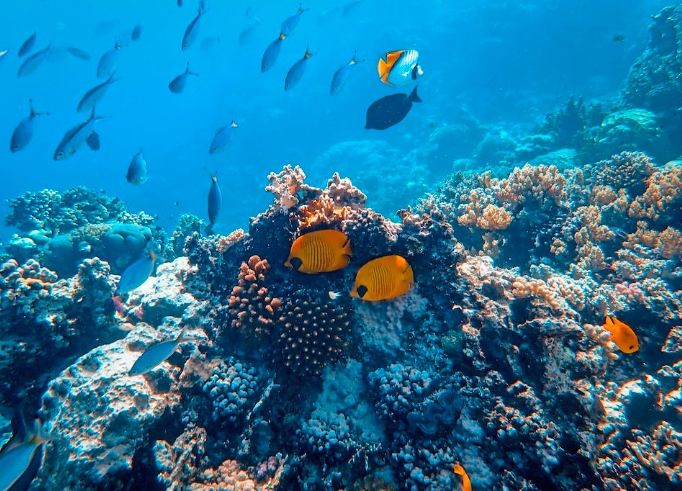Under the Sea: A Guide to Fish Care is an essential resource for anyone interested in learning more about the care and maintenance of pet fish. Keeping fish as pets has become increasingly popular in recent years due to their beauty, affordability, and low maintenance needs. Fish can make wonderful additions to any household and can bring joy, companionship, and relaxation to their owners. With this guide, you will learn all the basics of fish care, from choosing the right tank and fish species to providing proper nutrition and water quality.
Having a pet fish can be a wonderful experience, but it is important to understand their needs in order to be a responsible owner. Fish are living creatures and require special attention and care. This guide provides the necessary information to ensure that your fish will have a healthy and happy life. You will learn about the different types of fish, the best tank size and setup, appropriate nutrition and water conditions, and the signs of disease and other medical issues. By following the advice in this guide, you can ensure that your fish will remain healthy and live a long, happy life.
Choosing the Right Fish
Tips for Choosing the Right Fish
1. Research the fish type: Before purchasing a fish, you should familiarize yourself with the type of fish you are interested in, its size, and other necessary information.
2. Consider the tank size: The size of the tank should be considered before purchasing a fish. If the fish is too large for the tank, it will become unhealthy and stressed.
3. Avoid overcrowding: Overcrowding is not conducive to a healthy environment. Therefore, it is important to consider the number of fish you plan to keep in the tank.
4. Consider compatibility: When selecting fish for a tank, it is important to consider the compatibility of the species. Some species do not do well together so research should be done before selecting fish for the tank.
5. Check the water temperature: Different types of fish require different temperatures. It is important to ensure that the water temperature is suitable for the fish you wish to purchase.

How to Select Healthy Fish from a Pet Store
1. Inspect the fish: Carefully inspect the fish before making a purchase. Look for signs of illness such as spots, slimy skin, or bulging eyes.
2. Check the water quality: The water quality should be checked for clarity and ammonia levels. If the water appears cloudy or murky, it is a sign that the fish are not being kept in the best conditions.
3. Observe the behavior: Pay attention to the behavior of the fish. If the fish appear lethargic or listless, it is a sign that the fish may be unhealthy.
4. Ask questions: If you have any questions about the fish or the tank, do not hesitate to ask the store staff. They should be able to provide you with the necessary information.
5. Seek professional advice: If you are unsure of what type of fish to purchase, it is advisable to seek professional advice from an experienced pet store employee.
Setting Up Your Aquarium
A properly set up aquarium is essential for the health and happiness of your fish. It is important to ensure that each step of the setup process is done correctly to ensure a healthy environment for your fish. Here are some tips to help you get started: Choosing the Right Tank:
• Choose a tank that is appropriate for the size of the fish you want to keep. Consider factors such as the size of the tank, the number of fish that will inhabit it, and the type of fish.
• Make sure the tank is properly supported and secured.
• Decide on the type of tank you want, either glass or acrylic. Research the pros and cons of each type before making a decision.
Selecting the Right Filtration System and Heater:
• Choose a filtration system that is suitable for the size of the tank and the number of fish.
• Make sure the filtration system is powerful enough to keep the tank clean and clear.
• Consider the type of filter you want, such as a canister filter, an undergravel filter, or a hang-on-back filter.
• Choose a heater that is appropriate for the size of the tank and the type of fish you have.
• Select a heater that is designed to maintain a consistent water temperature.
Setting Up the Tank:
• Place the tank in an area that does not receive direct sunlight.
• Clean the tank and all other accessories before filling the tank with water.
• Fill the tank with water and then add any necessary additives or treatments.
• Install the filter and heater and make sure they are working properly.
• Allow the tank to cycle for a few days before adding any fish.
• Test the water regularly to ensure proper water quality.
Adding Fish:
• Choose fish that are suitable for the size of the tank and the type of water in the tank.
• Acclimate the fish to the tank before adding them.
• Only add a few fish at a time or a few each week to help the tank cycle properly.
• Monitor the fish and the water parameters regularly to ensure proper water quality.
• Feed the fish a healthy diet and give them plenty of space to swim.
By following these steps, you can ensure that your aquarium is properly set up for the health and happiness of your fish. With the right setup, you will enjoy watching your fish thrive in their new home.
Feeding Your Fish
Having a balanced diet is essential for all living organisms, including fish. Fish require a variety of different foods to sustain their health. A variety of food items such as flakes, pellets, frozen, live and freeze-dried food should be included in their diet.
Flakes and pellets are the most commonly used food for fish, and they provide a good source of nutrition. Flakes are small bits of dried fish food that are easy to digest, and pellets are larger pieces of fish food that are also easy for fish to eat. Both of these types of food will provide a balanced diet for your fish.
Frozen and freeze-dried food are also popular options for fish. Frozen food is usually made up of small pieces of raw fish that have been frozen to preserve their freshness. Freeze-dried food is made up of dried fish food that has been rehydrated and is often a more expensive option. Both of these types of food are good sources of nutrition for fish and can be used to supplement the diet of fish that are picky eaters.
When it comes to feeding your fish, it is important to do so on a regular basis. It is recommended that you feed your fish at least twice a day, with each feeding amounting to no more than 10% of the fish’s body weight. For example, if your fish weighs 5 grams, it should be fed no more than 0.5 grams of food per feeding. It is also important to avoid overfeeding your fish as this can lead to health issues.
Maintaining Your Aquarium
Importance of Regular Water Changes and Aquarium Maintenance
Regular water changes and maintenance are essential for the health of your aquarium. The water in your aquarium needs to be changed regularly to ensure it remains clean and clear. This helps to reduce the amount of waste, nitrates, and other contaminants that can build up in the water over time. Regular water changes also help to maintain the balance of beneficial bacteria in the aquarium, which are necessary to keep the aquarium healthy.
How to Test Water Quality and Make Adjustments
Testing the water quality of your aquarium is an important part of maintenance. You should use a testing kit to check the water parameters such as pH, ammonia, nitrites, nitrates, and other compounds. Based on the results, you can make adjustments to the water parameters to make sure they are optimal for the fish and plants in your aquarium.
Cleaning and Maintaining Aquarium Equipment
Cleaning and maintaining aquarium equipment is essential for the health of your aquarium. Regularly check and clean any filters, pumps, and other equipment in your aquarium. Make sure to replace filter cartridges and other parts regularly to ensure they are working correctly. You should also regularly check the aquarium lights and replace any bulbs that are no longer working.
Common Fish Diseases
Overview of Common Fish Diseases and How to Prevent Them
Fish diseases are caused by a range of pathogens, including bacteria, viruses, fungi, and parasites. In addition to these, fish can also be affected by environmental factors such as poor water quality, overcrowding, and stress. The most common fish diseases are bacterial and parasitic infections. These can be prevented by providing good water quality, a healthy diet, and proper quarantine procedures.
Symptoms of Illness to Watch Out For
When monitoring the health of your fish, it is important to look out for any signs of illness. Common symptoms include loss of appetite, cloudy eyes, clamped fins, frayed fins, red streaks, red spots, white spots, bumps, ulcers, and patches of missing scales. If you notice any of these symptoms, it is important to take action quickly to prevent further damage to the health of your fish.
How to Treat and Prevent Common Fish Diseases
If your fish is showing signs of illness, it is important to immediately take action to provide a treatment and prevent further damage to the health of the fish. Treatment will depend on the type of disease, but treatment options may include antibiotics, dietary supplements, and quarantine procedures. In addition to treatment, it is important to take steps to prevent common fish diseases. This can include providing a healthy diet, maintaining good water quality, and avoiding overcrowding and stress.
Breeding and Reproduction
Understanding Fish Breeding and Reproduction
Fish breeding and reproduction is the process of producing more fish by the union of two adults of the same species. The process starts with the courtship of the two fish, followed by the female releasing her eggs and the male releasing his sperm. The eggs are then fertilized, and when they hatch, the process of raising fry (young fish) begins. This process requires knowledge of the species, environmental factors, and water conditions, as well as the use of special breeding and raising techniques.

Different Breeding Techniques for Different Fish Species
The breeding techniques used for different fish species depend on the species itself. Some species require special breeding tanks, while others do not. Some species require special water conditions, while others do not. Some species require specific diets, while others do not. Some species require special spawning substrates, while others do not. It is important to research the particular species of fish before attempting to breed them.
Caring for Fry and Juvenile Fish
When the fry hatch, they must be cared for properly in order to ensure their survival. This includes providing them with the correct water conditions, diet, and living environment. Fry must be fed live food such as brine shrimp and daphnia. Juvenile fish must also be cared for properly, as they are more delicate than adults. The water conditions, diet, and living environment must be appropriate for the species. In addition, it is important to monitor the health of the juvenile fish and to provide them with the appropriate medications if necessary.
Conclusion
Under the Sea: A Guide to Fish Care has been a comprehensive guide to help you understand the basics of fish care and maintenance. From understanding the different types of fish, to learning the appropriate aquarium setup, to providing the best nutrition for your fish, this guide has been a comprehensive source of knowledge for anyone wanting to own and care for a fish.
It has been our hope that with this guide, you now have a better understanding of how to properly care for your fish and keep them happy and healthy. Whether you are a beginner or an experienced aquarist, we believe that with the information provided, you can confidently provide your fish with the best care possible.
We understand that owning and caring for fish is not always easy, but with dedication, patience, and knowledge, you can create a healthy and happy environment for your fish to thrive. We hope that this guide has been able to provide you with the necessary information to make sure that you can give your fish the best care that they need and deserve.
FAQs
1. What type of fish is best for a beginner?
An ideal beginner fish is one that is easy to care for and hardy enough to withstand minor fluctuations in water quality. Good starter fish include bettas, goldfish, danios, mollies, and guppies.
2. What are the essential elements of a fish tank?
A successful fish tank includes a tank, filter, substrate, decorations, lighting, heater, thermometer, and a water test kit.
3. How often should I change my fish tank water?
Most aquarium experts recommend changing at least 10-25% of your tank water every two weeks, or 25-50% of your tank water every four weeks.
4. What is the best way to clean a fish tank?
To clean your tank, use a gravel vacuum to remove excess debris from the substrate, then use a sponge or algae scraper to remove any algae buildup from the walls and decorations of the tank.
5. What kind of fish can live together?
Fish compatibility depends on the size, habitat requirements, and temperament of the fish. Generally, fish of similar sizes and habitats can be kept together, while aggressive fish should be kept separate.
6. What do fish eat?
Most fish require a variety of foods, including flake food, freeze-dried food, live food, and frozen food. Some fish may need special diets, such as herbivorous fish that require a vegetable-based diet.
7. How do I know if my fish are healthy?
Healthy fish are generally active and swim around the tank, have bright colors, and have clear eyes. If your fish are showing signs of illness, such as abnormal swimming behavior, white spots, or cloudy eyes, contact your local fish store for advice.
8. What temperature should my fish tank be?
Most aquarium fish prefer water temperatures between 76-82 degrees Fahrenheit. Some species may prefer warmer or cooler temperatures, so research your particular species to determine the ideal temperature.
9. How often should I feed my fish?
Most fish should be fed once a day, but some species may need to be fed multiple times a day. Overfeeding can cause water quality issues, so it’s important to research your species to determine the ideal feeding schedule.
10. What is the best filter for a fish tank?
The best filter for your tank depends on the size and type of tank, as well as the type of fish you are keeping. Generally, hang-on-back filters, canister filters, and internal filters are all good options for most tanks.


















